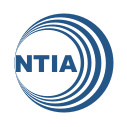The government’s plan to auction spectrum in the so-called AWS-3 band received a significant boost this week as the Department of Defense agreed to relocate current operations in the 1755-1780 MHz band to a shared arrangement in the 2025-2110 MHz band. The move will free up the 1755-1780 MHz band to now be paired with the 2155-2180 MHz band into a 50 megahertz chunk of spectrum with separate uplink and downlink channels to be auctioned off for cellular operations.
In a letter to the Federal Communications Commission, the National Telecommunications and Information Administration laid out an agreement it had reached with the DoD on the arrangement that will see the DoD move to a bigger slice of spectrum that it will share with television services. The letter was filed in connection with a recent notice of proposed rulemaking released by the FCC.
The move will open up the 1755-1780 MHz band that is currently occupied by the DoD for use as an uplink channel connected to the 2155-2180 MHz band for use as a downlink channel. The FCC has said it was looking to auction off that 50 megahertz of spectrum by the end of next year.
The DoD announced earlier this year that it was willing to work on freeing up spectrum, claiming a move would not cause a significant impact to its operations. At that time the DoD noted that it could cost up to $3.5 billion to move operations from those bands. The 2155-2180 MHz band had been at the center of potential interference issues and the topic of extensive negotiations for five years.
The FCC, along NTIA, is looking to fulfill President Obama’s mandate to allocate up to 500 megahertz of new spectrum to support commercial wireless services. In addition to the 1.7/2.1 GHz band, the FCC is setting up rules to auction off spectrum in the 600 MHz band that is currently being used by television broadcasters and plans to auction 10 megahertz of spectrum in the upper 1.9 GHz band (H-Block) early next year.
The 1.7/2.1 GHz band is increasingly being looked at by domestic operators to support LTE services, with Verizon Wireless and AT&T Mobility both looking at that band for adding capacity to their current LTE deployments, while T-Mobile US is relying heavily on that band for the bulk of its LTE coverage. All three operators are expected to be interested in the AWS-3 band to bolster current deployments.
Sprint and T-Mobile US have noted that they would not be participating in the H-Block auction, which would seem to leave Dish Network as the front-runner to pick up those assets. T-Mobile US, which has recently raised several billion dollars for potential spectrum acquisitions, along with Sprint have expressed interest in getting their hands on sub-1 GHz spectrum holdings.
Bored? Why not follow me on Twitter?

